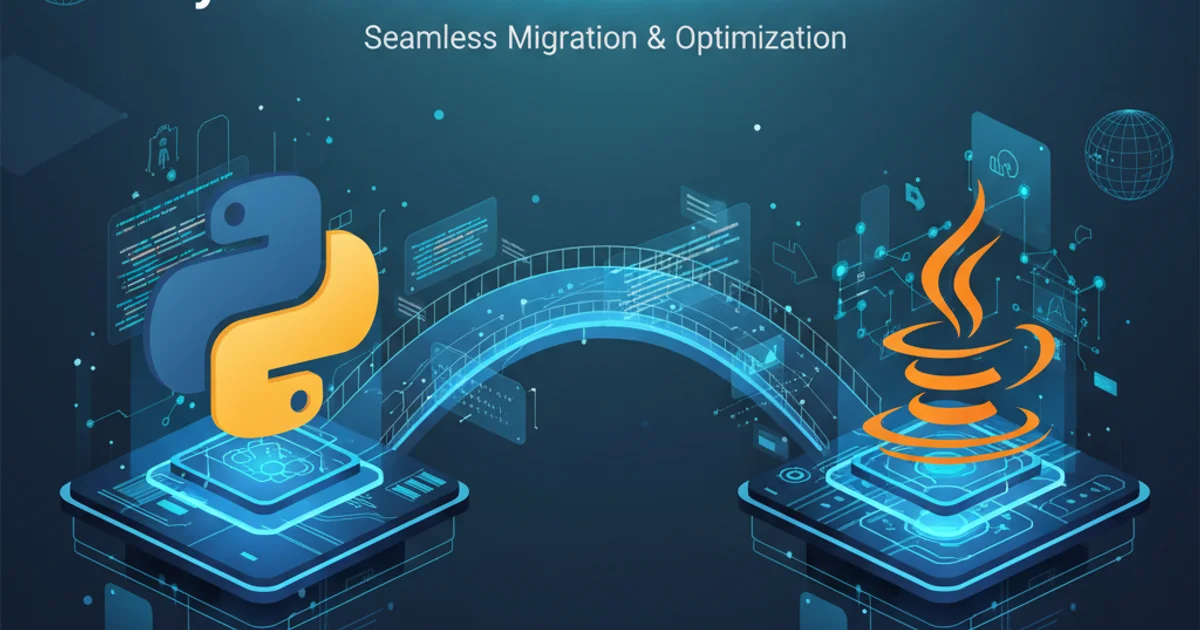Python to Java code conversion
Categories:
Bridging the Gap: Converting Python Code to Java

Explore strategies, challenges, and best practices for translating Python codebases into Java, leveraging common patterns and language features.
Converting code from one programming language to another is a common task in software development, often driven by factors like performance requirements, ecosystem integration, or team skill sets. Python and Java, while both powerful, have distinct paradigms, type systems, and standard libraries. This article provides a comprehensive guide to understanding the nuances of converting Python code to Java, offering practical advice and examples.
Understanding Fundamental Differences
Before diving into direct conversion, it's crucial to acknowledge the core differences between Python and Java. Python is dynamically typed, interpreted, and often favors conciseness, while Java is statically typed, compiled, and emphasizes explicit structure and object-oriented principles. These differences impact everything from variable declarations to error handling.
flowchart TD
A[Python Code] --> B{Analyze Data Types}
B --> C{Map Control Flow}
C --> D{Handle Collections}
D --> E{Implement OOP Concepts}
E --> F{Refactor for Java Idioms}
F --> G[Java Code]
B -- Dynamic Typing --> C
C -- Indentation --> D
D -- List/Dict --> E
E -- Inheritance/Polymorphism --> F
F -- Performance/Concurrency --> GHigh-level process for Python to Java code conversion
Data Types and Variables
Python's dynamic typing means you don't declare variable types explicitly. Java, however, requires explicit type declarations for all variables. This is one of the first and most significant changes you'll encounter. You'll need to infer Python variable types and choose appropriate Java equivalents (e.g., int for Python integers, String for Python strings, double for Python floats).
name = "Alice"
age = 30
salary = 50000.50
is_active = True
String name = "Alice";
int age = 30;
double salary = 50000.50;
boolean isActive = true;
long in Java if it exceeds the int maximum value.Control Flow and Functions
Control flow structures like if/else, for loops, and while loops have direct counterparts in Java, though the syntax differs. Python's indentation defines code blocks, while Java uses curly braces {}. Python functions become Java methods, often requiring explicit return types and parameter types.
Python Function
def greet(name): if name: return f"Hello, {name}!" else: return "Hello, Guest!"
for i in range(5): print(i)
Java Method
public String greet(String name) { if (name != null && !name.isEmpty()) { return "Hello, " + name + "!"; } else { return "Hello, Guest!"; } }
for (int i = 0; i < 5; i++) { System.out.println(i); }
Collections and Data Structures
Python's built-in list, dict, and set are highly versatile. Java offers a rich Collections Framework with interfaces like List, Set, and Map, and concrete implementations such as ArrayList, HashSet, and HashMap. Choosing the correct Java collection is crucial for maintaining functionality and performance.
my_list = [1, 2, 3]
my_dict = {"key1": "value1", "key2": "value2"}
my_set = {1, 2, 3, 3}
import java.util.ArrayList;
import java.util.HashMap;
import java.util.HashSet;
import java.util.List;
import java.util.Map;
import java.util.Set;
List<Integer> myList = new ArrayList<>();
myList.add(1);
myList.add(2);
myList.add(3);
Map<String, String> myMap = new HashMap<>();
myMap.put("key1", "value1");
myMap.put("key2", "value2");
Set<Integer> mySet = new HashSet<>();
mySet.add(1);
mySet.add(2);
mySet.add(3);
Object-Oriented Programming (OOP)
Both Python and Java are object-oriented, but their approaches differ. Python supports multiple inheritance and duck typing, while Java uses single inheritance with interfaces. Translating Python classes often involves creating Java classes, defining fields (attributes) and methods, and carefully mapping inheritance hierarchies to Java's model.
1. Identify Python Classes
Locate all class definitions in your Python code. Understand their attributes and methods.
2. Create Java Classes and Fields
For each Python class, create a corresponding Java class. Translate Python instance variables to Java fields, ensuring correct types and access modifiers (e.g., private, public).
3. Convert Methods
Translate Python methods to Java methods. Pay attention to parameter types, return types, and the self parameter (which is implicit in Java instance methods).
4. Map Inheritance and Interfaces
If Python classes use inheritance, map them to Java's extends keyword. If Python's multiple inheritance or abstract base classes are used, consider using Java interfaces to achieve similar polymorphism.
5. Handle Special Methods
Python's __init__, __str__, __eq__, etc., correspond to Java constructors, toString(), equals(), and hashCode() methods, respectively. Implement these in Java as needed.